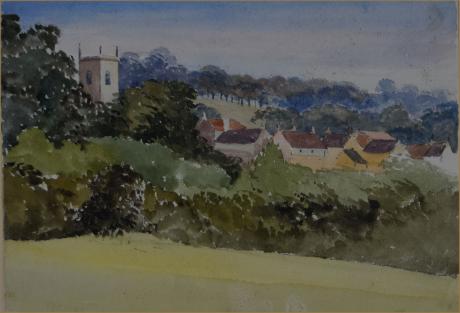inscribed and dated in the margin " Warkton Church Aug 21st 1884"
In the mid 18th century the medieval church was radically altered as it took on the mantle of the mausoleum of the Dukes of Montagu of nearby Boughton House. This had only slight effect on the body of the church where the nave received a plaster ceiling and in any case the 1868/9 restoration by Slater intensified it’s medieval qualities. Beyond the chancel arch though everything changed following the death of the second Duke in 1749. Here an entirely new chancel was formed with pairs of huge alcoves either side of the altar. In due course four magnificent monuments were raised- two by Roubiliac to the 2nd Duke and to his Duchess, the daughter of the great Duke of Marlborough, and then by 1782 to their daughter Mary, Duchess of Marlborough by Montagu by P.M. van Gelder and finally her daughter Elizabeth, Duchess of Buccleuch by Thomas Campbell, 1827. The first, that to John Duke of Marlborough was completed by Roubiliac in 1752. It shows charity erecting a sign to the Duke's memory with the Duchess grieving below. In the upper area a putto is busy hanging up an oval medallion containing the Duke's portrait. Charity stands with two children in the lower right corner about to receive ducal help. One of the children weeps whilst the other extinguishes the torch of life. As a momento of the Duke's military career various armaments make up the decorative show. The second monument, that to the Duchess completed by Roubiliac in 1753 is dominated by the three Fates arranged around a large garlanded urn. These mythical figures control everyone's destiny even that of the Duchess who was the grand daughter of the great Duke of Marlborough. Nearer the altar on the left side is the third tomb that of Duchess Mary's daughter Mary, Duchess of Montagu. It is by the Fleming P.M van Gelder, 1777 - 82. Unlike the two former tombs the sculptor takes advantage of the deep space and creates a neo classical stage set with the Duchess seated to the right with two children and an old woman and a large angel with outstretched wings. In contrast is that to the Duchess of Montagu's daughter which stands opposite. Elizabeth, Duchess of Buccleuch died in 1827. The sculptor entrusted with filling the final alcove was Thomas Campbell. The spirited qualities of the 18th century monuments are now absent. Replaced by sober classism. The duchess sits straight backed in the centre in a pose reminiscent of Campbell's Roman antecedent Canova
Warkton is a nucleated village and civil parish in the English county of Northamptonshire. It is about three miles north-east of the town of Kettering and forms part of the borough of Kettering. At the time of the 2001 census, the parish's population was 144 people, reducing slightly to 136 at the 2011 Census.
The Grade I listed parish church of St Edmund is particularly noted for containing four Baroque marble monuments erected between the 1750s and 1830s to members of the local Montagu family of Boughton House. The monuments are housed in four niches in the specially constructed chancel. The original medieval (probably Norman) chancel was demolished to make way for its construction. The east window is large and of clear glass, flooding the chancel with light to show the white marble monuments at their best. Monuments to John Montagu, 2nd Duke of Montagu (1690–1749), and his wife, Mary Churchill (1689–1752) are by the renowned sculptor Louis-François Roubiliac. A third monument to Mary Montagu (1711–1775), daughter of John and Mary, is by Pieter Mathias van Gelder (1742–1824). These first three monuments are of very high quality, rivalling the Roubilliacs in Westminster Abbey. The fourth monument, to Elizabeth Scott, Duchess of Buccleuch (1743–1827), daughter of Mary, is by Thomas Campbell (1790–1858) and, though very fine, is of significantly lesser quality than the other three. The private family burial vault, adjacent to the chancel, contains the mortal remains of those celebrated in the monuments, together with their children, many who died in infancy, and Ralph Montagu, 1st Duke of Montagu (1638–c. 1709).


